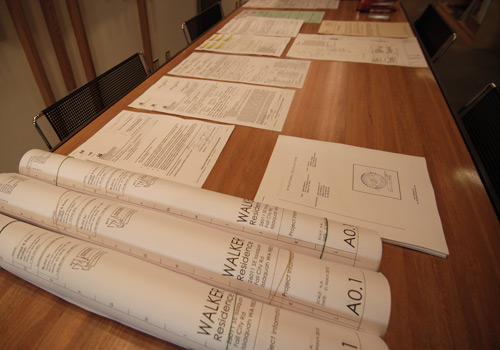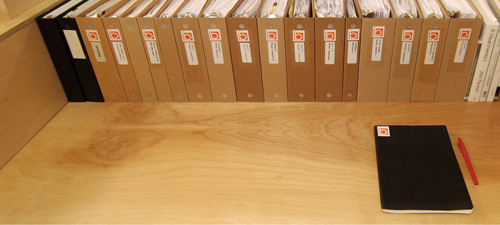
Last week was 5 days full of permit submittals, paperwork and bureaucratic navigation. Snooze-fest, you’re thinking. As designers and creative thinkers, it’s a justified assumption that we architects would rather drop bricks on our feet all day than spend our time on permit submittal paperwork. Wake us up when there’s something that needs to be designed. This is merely the mind-numbing, college textbook-caliber boredom-inducing activity, right? Well, actually, no. In fact, we love this stuff. Over the years, we’ve learned to be passionate about items that may not seem like architecture on the surface but are necessary steps in the process to do the work of architecture well. And while the table full of paperwork below may make some want to gouge their eyes out with their second-favorite black ink pen, it gets our gears spinning. Stay with us on this. We realize this may require a bit of explaining.

Today’s post covers six important characteristics of being an architect in today’s economy. These items are not the usual suspects, and though they aren’t the formula to being a good designer, good design is at the very root of their successful execution. Additionally, creative thinking is not expressed as one of the points explicitly, but none of them can be adequately achieved without it. The qualities that made our list are not the ones professors discuss much in the classroom, if at all. But in our opinion, mastering these characteristics plays a huge part in separating the grown-up work of professional architecture from child’s play. Each item dispels a common illusion that architects spend their days designing glamorous projects that the world has never before laid eyes on, drawing with broad strokes and creating slick renderings. Rather, the following points are the hard-workers behind the scenes; they are the structure that allows good design to happen.
Taking an interest in reality
While it may sound funny to say this out loud, it consistently amazes us how many architects trade in reality for ungrounded optimism. Navigating through the building code, generating schedules and taking budgets seriously are all necessary to the process of getting real work built. More often than not, reality looks like the table full of documents above.
Being a generalist
Getting good, modern architecture built involves a broad spectrum of tasks and a requires a robust bandwidth. The kind of architects that get things built wear as many caps as it takes to get the job done. It’s not unusual for us to dig a hole on site or coordinate with a construction loan officer. It may not be considered architecture in its purest form, but without covering some of these tasks, there may not be any architecture in its tangible form.

Modernism is a way of life
Modern design doesn’t just apply to the clean horizontal lines of a roof eave or the unencumbered geometry of a floating stair tread. Having a modern philosophy applies to nearly everything architects do. There is just as much attenuation, care and consideration in a thorough building code analysis or a complete permit submittal as in detailing that infinity edge swimming pool. Unfortunately, the paperwork doesn’t photograph quite as well.
Housekeeping
We’ve never understood how anyone can properly design and organize an entire house or a building if they can’t even keep their desk tidy and their files organized. They each stem from a common skill-set.

Turning complexity into something comprehensible
So much of architecture involves filtering through a mountain of complex, nebulous information. In order to do anything with all that data, it needs to be properly organized and understood. The points above equip an architect to efficiently sift through the building code, accessibility code, municipal code, fire code, etc., and obtain usable information.
Making data beautiful
Being able to sort the important information from the useless is critical. What an architect does with this information has significant impacts. Data that is readable, comprehensible, and pleasing to the eye forwards the discussion and makes negotiating easier with clients, permit reviewers and inspectors.
Maybe you’ve got some additional items for the list—hit that comments button and get ’em up here. Or maybe you had a professor back in school that did emphasize some of these points—we’d love to know who they are and give them some kudos.
Cheers from team BUILD





